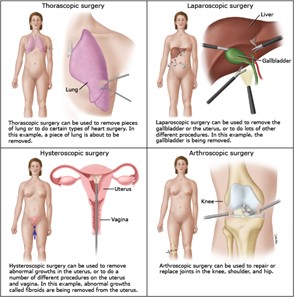Minimally invasive surgery is a type of surgery that uses special tools designed to decrease the size of incisions and reduce how much the body’s tissues get damaged.
One kind of minimally invasive surgery involves the use of a “scope,” a viewing device that allows surgeons to look inside the body without opening it up all the way. Another type, called “endovascular surgery,” uses X-rays to see inside the body while the surgeon uses special devices that fit inside the blood vessels. This article is about the type of surgery that involves scopes.
There are several different types of scopes, but they all work in about the same way. They consist of a long, thin tube with a tiny camera and a light on the end. The camera sends pictures of the inside of the body to a TV screen. When doing this type of surgery, the surgeon makes a small incision just big enough for the scope to fit through. They also make 2 or more other incisions that slim tools can fit through. These tools include clamps, scissors, and stitching devices, which the surgeon can control from outside the body. While looking at the picture on the screen, the surgeon uses those tools to do the operation.
There are lots of different types . Their names are based on the body parts that are involved. The scopes used for the different types of surgery are named that way, too:
- Thoracoscopes are used in the chest for “thoracoscopic surgery.” (“Thorax” is Greek for chest.) This type of surgery can be used to remove pieces of lung or to do certain types of heart surgery.
- Laparoscopes are used in the belly for “laparoscopic surgery.” (“Lapara” is Greek for the space between the bottom of the rib cage and the hips.) This type of surgery can be used to remove the gallbladder, appendix, or uterus, or to do lots of other different procedures.
- Hysteroscopes are used in the uterus and vagina for “hysteroscopic surgery.” (“Hystera” is Greek for uterus.) This type of surgery can be used to remove abnormal growths in the uterus, or to do a number of different procedures on the uterus and vagina.
- Arthroscopes are used inside joints for “arthroscopic surgery.” (“Arthron” is Greek for joint.) This type of surgery can be used to repair or rebuild joints in the knee, shoulder, and hip.
Some minimally invasive surgeries involve a surgical “robot,” which is a machine that the surgeon controls. This is called “robot-assisted minimally invasive surgery” or simply “robotic surgery.” The tools used in robotic surgery allows for more controlled movements than regular tools.
In general – but not always – this type of surgery makes recovery easier. That’s because:
- It usually involves several small wounds, rather than one big one
- The organs don’t get moved around as much
Despite all of the differences with regular surgery, minimally invasive surgery is still surgery. People who have it do have some pain, they do often need stitches, and they can develop infections or other problems because of the surgery.
No. Many procedures can now be done through a minimally invasive approach. But it’s not entirely up to the person to choose what type of surgery they will have. Whether or not a person can have this type of surgery will depend on:
- Whether there is a surgeon available with enough experience doing the type of surgery the person needs
- Why the person needs surgery. (As an example, people who need surgery to remove very large cancers cannot always have minimally invasive procedures.)
- What other health problems the person might have (As an example, people who have serious heart or lung problems cannot tolerate minimally invasive surgery.)
Even when a person starts out having minimally invasive surgery, there’s no guarantee that the surgery will stay that way. Sometimes surgeons start out doing minimally invasive surgery and then switch to open surgery because they find something unexpected. This doesn’t mean the surgeon has done anything wrong. It is usually done to protect the person’s safety.




